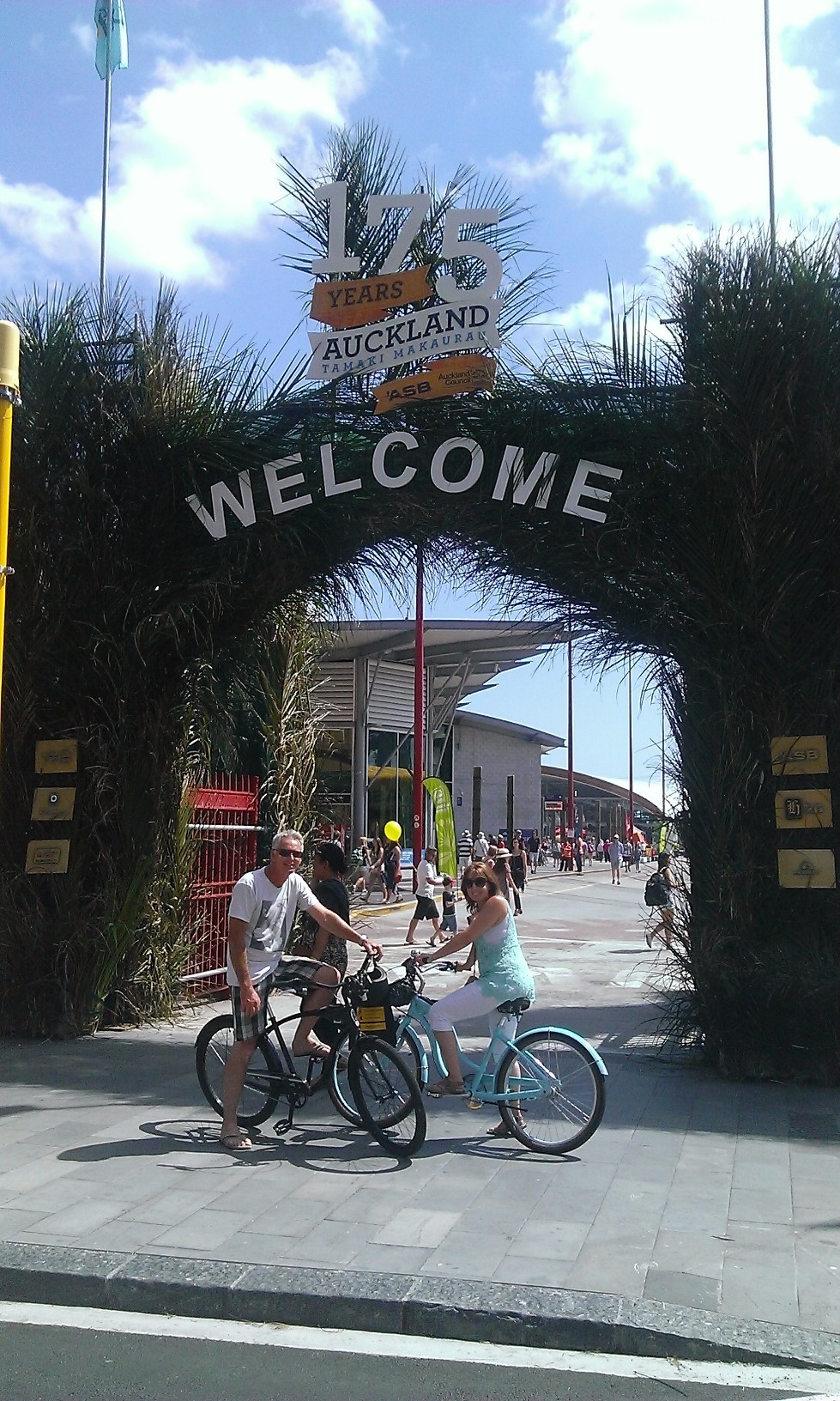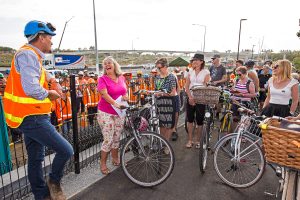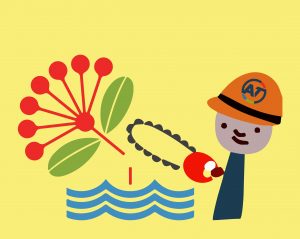Notice of Motion: Auckland Transport Street Tree Planting Policy
A notice of motion is a useful tool available to elected representatives to get action on an issue when the organisation fails to respond by other means. As lead of the transport porfolio for the Waitemata Local Board I have a particular interest in what goes on in the road corridor managed by Auckland Transport. I want our streets to be safe, vibrant, well connected and beautifully designed for everyone to enjoy. I’ve come to appreciate how much trees benefit our urban environment and can enhance every transport-led project (not to mention act to reduce GHG emissions).
However what I have come up against time and time again is the lack of a standard practice or policy to ensure Auckland Transport plants street trees. Many oppportunities are being missed to add trees to the city streetscape. Individual project managers are doing their best but the budget arrangements between AT and Auckland Council parks are a block to trees being incorporated into street designs and renewal projects. I’ve set out these issues and examples below by way of background to my Notice of Motion.
At the Waitemata Local Board meeting last night (14 June 2016) my recommendations were unanimously passed (seconded by Member Dempsey). We all recognise the huge value of street trees and would like to help Auckland Transport progress a tree planting policy for Auckland.
Recommendation
a) That the Notice of Motion be received.
b) That the Waitematā Local Board:
i) notes the benefits of urban street trees and the Auckland Plan, City Centre Master Plan and Waitematā Local Board Plan 2014 commitment to plant street trees;
ii) requests Auckland Transport in association with Auckland Council Parks develop:
- A street tree planting policy; and
- A strategy to meet the City Centre Masterplan street tree target of a 25% increase by 2021;
iii) requests Auckland Transport allocate budget (capex and opex) for funding new street trees as part of streetscape projects and footpath renewals;
iii) requests that this Notice of Motion is circulated to all Local Boards, the Parks, Recreation and Sports Committee, Auckland Development Committee, Auckland Transport Board and Chief Executive and Auckland Council Policy and Bylaws team
Background
Auckland Council, with the support of the Waitematā Local Board, has made a clear commitment to plant street trees in the urban environment.
Directive 8.2 of the Auckland Plan is to protect, enhance and increase Auckland’s green infrastructure networks. Auckland Council is committed to increasing the number of trees on reserves and streets. Council has committed to valuing natural heritage and ‘greening’ Auckland’s expanding network of open public spaces which provides for a more attractive city, while reducing GHG emissions and improving community resilience to the effects of climate change and resource scarcity and by supporting local food production.
As outlined in the Waitematā Local Board Plan, the board supports “increasing the number of native plants and trees in our parks and streets to help restore biodiversity” (Local Board Plan 2014, page 32).
In the Becoming a Local Carbon Community Action Plan (August 2015) we have committed to an Action Area of Enhancing the Urban Forest and Biodiversity.
As part of the Urban Forest Mapping Project Report for Waitematā we committed $2500 to draw up a tree inventory and to collect data in order to analyse the urban forest layer in the local board area. This work will assist us in assessing the need and timing for the replacement of trees.
In February 2016 the City Centre Masterplan targets were reviewed and revised targets approved by the Auckland Development Committee. The Local Board supports Outcome 8: An exceptional natural environment and leading environmental performer and the revised target of increasing streets trees in the city centre by 25% by 2021.
Street trees provide a range of benefits in the urban environment including:[1]
- Improve pedestrian safety by slowing traffic
- Good for business by increasing foot traffic in town centres
- Reduce crime
- Improve the health and wellbeing of neighbourhoods by increasing the attractiveness and security of walking
- Reduce the need for drainage infrastructure
- Provide shade
- Provide oxygen and sequester carbon
 In the photo left Pohutukawa trees on Great North Road saved from road widening with the support of the Waitematā Local Board for future generations to enjoy.
In the photo left Pohutukawa trees on Great North Road saved from road widening with the support of the Waitematā Local Board for future generations to enjoy.
Auckland Transport is responsible for planting trees in the road corridor on behalf of Auckland Council. The responsibility for the ongoing care and maintenance of streets sits with Auckland Council Parks.
Despite the clear benefits of street trees and the Auckland Council commitment to increase street trees, Auckland Transport doesn’t have a policy to ensure street trees are planted in the urban environment. Auckland Transport also doesn’t have a strategy to meet the City Centre Masterplan street tree target. The responsibility to consider the addition of street trees is left with individual project managers on a case-by-case basis.
Auckland Transport has confirmed that street trees will only be included in a project if a specific budget is identified for the planting and for the ongoing water/maintenance cost. If there is no budget for ongoing maintenance (for at least 1 year) Auckland Council Parks will not agree to take on the responsibility for new trees.
Auckland Council Parks have provided the following response:[2]
Parks advocate for the inclusion of new tree assets in the road corridor where private development impacts on public open space and where AT is delivering renewals and streetscape upgrades. However, Parks only plays an advisory role (ie we are asked to comment on designs) in the majority of instances. If council is to deliver positive outcomes at all opportunity Auckland Transport and the consenting arm of council need to incorporate conditions around additional tree planting and which for the following reasons may be difficult to do or will require additional funding:
- New tree planting in the road corridor or within public open space is not a requirement of private development and there are no rules requiring resource consent applicants to plant anything unless they are seeking approval to remove existing vegetation or regulatory consider there are adverse visual effects from the development that need mitigating
- Footpath renewal budgets do not come with additional budget to plant new trees.
- Tree planter boxes, or in ground planters, can only be funded by new projects through CAPEX and Community Facilities only accept them from a maintenance perspective when there are funds put aside for their ongoing maintenance. The same would apply to private development projects in the road corridor / public open space.
Parks will of course continue to advocate, with the relevant stakeholders and partners, for the urban forest and support tree planting wherever it is practical (ie accounting for in ground services, footpath widths, AT design requirements etc), but local board involvement may help provide a more focused approach across the relevant departments / organisations either by escalation or a board workshop to which key officers / managers from Parks (Community Services and Facilities), AT and regulatory are invited.
Currently, the only two funding sources that have been identified to cover the additional consequential opex costs associated with a new street trees (or planters) are either that it is Auckland Transport provided or, if the project was initiated by the Local Board, Locally Driven Initiative (LDI) funded.
The Local Board should not have to fund maintenance costs for new street trees that are associated with non-Board projects. As an Auckland-wide commitment, new street trees should be funded as an asset from a governing body controlled budget.
The following examples illustrate the various situations in which Auckland Transport is failing to take up opportunities to plant street trees.
The footpaths on Graham Street were recently renewed on a like-for-like basis following completion of a new development. The Local Board was not informed in advance and no consideration was given to the inclusion of street trees.
- Streetscape upgrades or footpath works associated with private developments
Works associated with the new Countdown development on Williamson Ave included street trees and the closing of Rose Road to create a pedestrian plaza. Unfortunately, only the street trees on the southern side of Williamson Ave alongside the supermarket were included in the resource consent conditions. With the agreement of Auckland Transport, Countdown contractor re-configured Rose Road with an expanded footpath but no steps were taken to include trees (photo right).
 Since this issue was raised by the Local Board, Auckland Transport agreed in March 2016 to include three new tree pits. These tree pits will now have to be retrospectively installed into the footpath at Auckland Transport’s expense.
Since this issue was raised by the Local Board, Auckland Transport agreed in March 2016 to include three new tree pits. These tree pits will now have to be retrospectively installed into the footpath at Auckland Transport’s expense.
- New streetscape upgrades
When Auckland Transport undertook the upgrade of the Scotland Street/College Hill intersection as a safety project, the Local Board requested that the project include a street tree or appropriate greening.
 Auckland Transport supported a planter and had funds to pay for it but Auckland Council Parks did not support it because of the lack of funding for the ongoing maintenance.
Auckland Transport supported a planter and had funds to pay for it but Auckland Council Parks did not support it because of the lack of funding for the ongoing maintenance.
Auckland Council Parks supported a street tree but Auckland Transport was not willing to include a tree pit in the design because of underground utilities.
Since the photo left was taken two car parks have been reinstated but the Board is still waiting for a resolution with regards to the inclusion of some kind of greening.
[1] Burden, D., Walkable Comunities, Inc., Glatting Jackson. (2006) Urban Street Trees: 22 Benefits, Specific Applications. https://www.michigan.gov/documents/dnr/22_benefits_208084_7.pdf
[2] Email from David Barker | Environment and Programmes, Parks, Community Services.
Related reading
Transport benefits of street trees
In Praise of City Trees – Patrick Reynolds



















